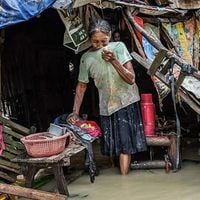As the Philippines braced itself for yet another onslaught of severe weather in November 2025, the nation found itself at the center of a powerful convergence of natural forces and policy innovation. Tropical Depression Verbena, the 22nd cyclone to enter the Philippine Area of Responsibility this year, swept across the central archipelago, leaving a trail of flooded communities, damaged homes, and disrupted livelihoods in its wake. But unlike in years past, the response to this and other recent storms has revealed a striking shift in how the country manages disaster risk—one that blends anticipatory action, international cooperation, and local resilience.
According to ALBAWABA, Verbena strengthened slightly on November 25, 2025, as it tracked off the coast of Anda, Bohol, packing maximum sustained winds of 55 kph and gusts up to 75 kph. The storm had made landfall in Surigao del Sur late Monday before striking Bohol early Tuesday, bringing with it intense rainfall—up to 200 mm in just 24 hours—intensified by a shear line. The Philippine weather agency PAGASA warned that flash floods and landslides were likely across Eastern Visayas, Caraga, and the Bicol region, urging residents to remain on high alert.
In Caraga, where Verbena first made landfall, swollen rivers and rapidly rising waters forced the evacuation of more than 10,000 residents from low-lying barangays. Roads became impassable, ferry services were suspended, and at least six homes in the Dinagat Islands and Surigao del Sur were destroyed. Early reports indicated damage to rice fields and banana plantations running into the millions of pesos, though, remarkably, no fatalities were reported as of November 25. Sea travel across affected regions was halted as waves soared up to four meters, stranding passengers and interrupting vital supply routes. The National Disaster Risk Reduction and Management Council (NDRRMC) responded by raising its alert status to BLUE, deploying search-and-rescue units and prepositioning relief goods. President Ferdinand Marcos Jr. called on coastal and high-risk residents to heed evacuation advisories, emphasizing the importance of vigilance in the face of nature’s fury.
Yet even as the country grappled with the immediate impacts of Verbena, a quiet revolution in disaster governance was underway. As BusinessWorld reported in a joint piece by Francisco Tiu Laurel, Jr. and Lionel Dabbadie, the Philippines is moving from a reactive approach—waiting for disaster to strike before responding—to a model rooted in anticipatory action, scientific forecasting, and pre-emptive financing. This shift was on full display earlier in November, when the Department of Agriculture (DA) and the Food and Agriculture Organization (FAO) activated an anticipatory action pilot in Region II three days before Super Typhoon Fung-Wong (Uwan) made landfall. Working in concert with the Bureau of Fisheries and Aquatic Resources, the agencies released tailored agroclimatic advisories and took steps to protect crops, livestock, and fishing boats while it was still safe to do so.
The evidence for this new approach is compelling. According to the DA and FAO, anticipatory action can reduce disaster losses by up to 3.5 times compared with traditional reactive methods. For a country where agriculture is both a lifeline and a vulnerability, these gains are not just statistical—they are transformative. In November 2024, when six tropical cyclones, including Super Typhoon Man-Yi (Pepito), struck the Philippines in rapid succession, the country’s forecast-based financing system was put to the test. Once scientific triggers—such as wind speed, rainfall, and projected impacts on vulnerable communities—were met, funds and technical support were released within minutes, up to 72 hours before landfall. Thousands of families in Regions V and VIII received pre-disaster cash transfers and guidance to secure their assets, with 6,400 farmers and fishers in Catanduanes and Northern Samar each receiving P3,300 (about $56) before markets shut down. Cooperative groups evacuated 283 fishing boats, preserving livelihoods and demonstrating the economic logic of early action.
Institutional change has played a crucial role in making these advances possible. The passage of Republic Act No. 12287, the Declaration of State of Imminent Disaster Act, marked a watershed moment. The law allows national and local governments to declare an imminent disaster based on scientific risk assessments, enabling early measures three to five days before impact. This legislative shift closes a long-standing gap that previously forced officials to wait for damage before acting. Now, early budgeting, pre-disaster procurement, and forecast-based responses are not just permitted—they are expected. As a result, local governments and cooperatives in places like Catanduanes are increasingly able to activate early protocols independently, mobilizing volunteers, communicating advisories, and securing shared resources as part of regular practice.
Meanwhile, the international dimension of disaster response has been on full display. As reported by the U.S. Department of Defense, U.S. military forces concluded foreign disaster relief operations in the Philippines on November 16, 2025, following the impacts of Typhoons Fung-Wong and Kalmaegi. Approximately 500 U.S. personnel were deployed to Clark Air Base and Camp Aguinaldo, supported by six C-130s, four MV-22s, and three HH-60 helicopters. Their mission included transporting 10,000 family food packs to the island of Catanduanes in eastern Luzon, providing critical support in the aftermath of the storms. Typhoon Kalmaegi had made landfall in the Cebu region on November 4, after intensifying to 125 miles per hour, while Fung-Wong struck Luzon Island on November 9 with winds exceeding 115 miles per hour. The back-to-back storms caused severe flooding and loss of life, their impact compounded by their close succession.
Brig. Gen. Robert “Bams” Brodie, commanding general of the 3d Marine Expeditionary Brigade, emphasized the importance of the U.S.-Philippines alliance in crisis response, stating, “Our longstanding relationship with the Philippines was instrumental to form a bilateral crisis response force to render aid to those in need.” Col. Robb T. McDonald of the 15th Marine Expeditionary Unit echoed this sentiment, describing the relief mission as “a testament to the strength of the enduring relationship we have with the Philippines and provides a tangible demonstration of U.S. commitment to the Philippine nation.” The forward presence and readiness of U.S. forces in the Indo-Pacific region were pivotal to the rapid and effective response to these disasters.
Looking ahead, the challenge for the Philippines is to consolidate and scale these gains. As Francisco Tiu Laurel, Jr. and Lionel Dabbadie observed, scientific triggers and impact models must be continuously refined to better capture local realities—crop calendars, fishing cycles, microclimates, and market access. Early action protocols should be further integrated into agriculture, fisheries, and social protection programs, ensuring that interventions like seed protection, early harvesting, and boat evacuation become routine. The private sector, particularly logistics firms, financial institutions, and insurers, has a role to play in aligning products with forecast-based activation, helping to keep supply chains and financial lifelines open when storms approach.
Ultimately, the shift toward anticipatory action is about more than policy—it’s about changing mindsets. It challenges the notion that disasters are simply to be endured, replacing it with the conviction that losses can be reduced when decisions are based on science and made before the worst arrives. With tools, laws, and partnerships in place, the Philippines is forging a new path—one where communities, government, and international allies work together to protect lives and livelihoods before disaster strikes. The work ahead is demanding, but the foundation for a more resilient future has never been stronger.






